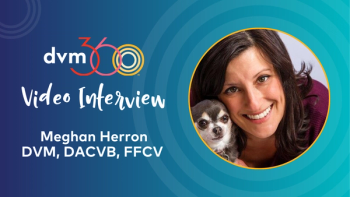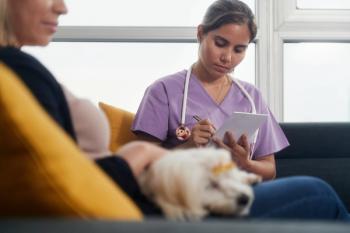
Reactive dogs: Practical tips for helping clients cope (Proceedings)
Remember Lassie? How about all those clever Dalmatians? People are inclined to adopt dogs of certain breeds when they see a dog of that breed behaving in an appealing manner. It is tempting to watch a border collie speed gracefully through an agility course and think, "Wow, I would like a dog like that."
Remember Lassie? How about all those clever Dalmatians? People are inclined to adopt dogs of certain breeds when they see a dog of that breed behaving in an appealing manner. It is tempting to watch a border collie speed gracefully through an agility course and think, "Wow, I would like a dog like that." It turns out that high drive working dogs expect to work. When jobs are not assigned and answers are not supplied, these dogs find their own tasks. These may include chasing and barking at people, dogs and cars.
Similarly, an individual mixed breed dog may be adopted from the shelter based on its enthusiasm against all odds. The excited dog that bounds forward at the sight of a leash or tennis ball may also bounce, bark, or lunge toward any object of interest.
Rather than wane with age, the intensity of a dog's undesirable reactions may escalate over time. There may be inappropriate intervention, inadvertent reinforcement, or there may be a genetic predisposition toward fearful or aggressive behavior.
A typical complaint might be that the dog does not walk well on leash. An owner may insist that his dog is friendly, yet the dog barks and leaps at passing people or dogs. Sometimes, the only complaint is uncontrollable jumping up on people.
The message is consistent: it is not pleasurable or relaxing to spend time with this dog. As a result, dogs that could benefit from exercise and social interactions are no longer taken on walks. The dog may be banned from participating in an obedience class if its behavior is disruptive. Embarrassed owners do not want to take their boisterous dog out in public. The bond between the owner and the dog stretches and breaks. If relinquished to a shelter, the dog may be deemed unadoptable.
Assessment
A behavioral evaluation should include screening for and identification of underlying anxiety or aggression. Dogs that behave aggressively toward their owners will need a carefully designed treatment plan that addresses any safety concerns. Redirected aggression is a consideration.
It may be difficult to determine whether the unwanted reaction was initially triggered by the dog's underlying anxiety, or whether the dog developed anxiety as a consequence of inconsistent reinforcement of the undesirable behavior. Similarly, unintentional reinforcement can support that development of aggressive behavior in a friendly but excitable dog. Consider the fate of the mail delivery person.
Treatment
Veterinarians can help owners understand the ways in which reinforcement can function to either support or extinguish a behavior pattern. The skills and schedule of the owner must be considered when developing a treatment plan. If the prognosis is poor for a particular dog / owner team, it may be necessary to discuss rehoming.
Encourage owners to return for follow up visits regularly, even every 2 weeks, until progress is under way. During the visit, evaluate both the dog's responsiveness and reactivity and the owner's ability to apply reinforcement. If a dog does not progress adequately, reevaluate the diagnosis. Treatment of reactive dogs can be very rewarding with a good prognosis.
Treatment Guidelines
1. Create a list of the behaviors that the owner wants to change. Prioritize.
2. Learn the triggers for the behavior(s) that will be addressed first.
3. In a quiet environment, teach necessary skills
• Consider working with a skilled trainer or technician if available
• Teach relaxation exercises in the absence of triggers
• Teach attention exercises in the absence of triggers
• Teach dogs to perform behaviors on cue: sit, look, look away
• Minimize exposure to triggers until these skills are mastered
4. Suggest tools for physical control—head halter, Easy Walk® harness
5. Introduce a single trigger
• Bring reinforcers
o Grade value of rewards—low through high
• Behavior modification
o Desensitization and counterconditioning
o Response substitution / countercommand
• Teach owners to stand quietly when necessary
o No commands if no attention
o Commands replace corrections: poorly timed punishment can exacerbate fear and aggression ultimately increase arousal
6. Offer appropriate outlets
• Dog sports
Newsletter
From exam room tips to practice management insights, get trusted veterinary news delivered straight to your inbox—subscribe to dvm360.





